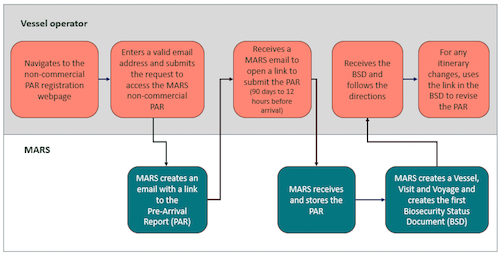Australia: New Biosecurity Reporting Procedures For Yachts
Australia’s Department of Agriculture, Forestry and Fisheries is implementing a new electronic pre-arrival report for non-commercial vessels arriving into the country, in a move to provide a one-stop shop for biosecurity pre-arrival reporting and streamline border processes.
Published 2 years ago
Biosecurity reporting requirements for yachts to change
The long-standing reporting requirements for non-commercial vessels intending to arrive in Australian territory are to contact the department’s key biosecurity port offices by email or phone using the Vessel Contacts or by contacting the Australian Border Force.
From 1 December 2023, a new and improved method of reporting is being implemented which requires all non-commercial vessels arriving in Australian territory to submit an electronic pre-arrival report (NCV PAR) using a web-based portal.
The PAR timeframe reporting requirements remain the same, that is, where the intention to arrive must be submitted 90 days to 12 hours before arriving in Australian territory.
The new system allows all international conveyances to submit pre-arrival information and documents, providing a one-stop shop for improved biosecurity pre-arrival reporting as well as a seamless traveller experience and streamlined inspection for efficiency at the border.
When the non-commercial vessel operator submits a PAR, questions relating to the biofouling management practices on the vessel must be answered. Once the PAR has been submitted, it will be automatically uploaded into the department’s Maritime and Aircraft Reporting System (MARS).
Non-commercial vessel operators will receive emailed Biosecurity Status Documents (BSDs) via MARS with biosecurity directions for arrival in Australian territory. BSDs are the single source of information for biosecurity directions and advice for each voyage. Attached is a quick reference guide on understanding BSDs.
MARS will also notify biosecurity officers of the impending vessel arrival, enabling biosecurity officers to engage with the vessel operator to prepare for arrival and commence biosecurity risk assessment.


The department’s PAR web portal
The non-commercial vessel PAR will be accessible from 1 December 2023, using this link – PAR Web Portal – or visit the non-commercial vessel webpage anytime which will have a link to the PAR.
What’s in the PAR?
There are questions about:
- the number of travellers;
- the vessel travel history and timber components of the vessel;
- plans for Australian port visits and estimated length of the stay;
- if there are any plants, insects, animals or hitchhiker animals or birds on board;
- will there be waste offloaded;
- and any measures undertaken to manage biofouling.
Reminder: It is a legal requirement to notify the department of impending arrival into Australian territory
All non-commercial vessels arriving in Australia are required by law to give notice, provide a pre-arrival report, to DAFF of impending arrival:
- before the vessel departs the last (international) port but no earlier than 90 days before arrival in Australian territory OR
- at least 12 hours before arrival into the First Point of Entry in Australian territory OR
- as specified by a biosecurity officer.
The ports where a non-commercial vessel can legally arrive
Non-commercial vessels may only arrive at some Australian ports from an international destination (the last port) if the port has been determined as a First Point of Entry (FPOE) for non-commercial vessels under s229 of the Biosecurity Act 2015. Read about the ports and other details for non-commercial vessels at: Non-commercial vessel arrival biosecurity reporting – yachts and private superyachts – DAFF (agriculture.gov.au)
Non-first point of entry
Australian territory ports that are not approved for non-commercial vessel arrivals are classed as non-first points of entry. These ports have not been able to have been assessed against the First Point of Entry (FPOE) biosecurity standards and may not have appropriate infrastructure or processes in place to manage biosecurity risk.
To arrive at a non-first points of entry port, vessel operators will need to apply and receive prior permission to arrive. To unload goods at an FPOE that is not determined for that class of vessel or goods is a separate application process.
How to request permission to moor at a non-first point of entry:
To moor, and unload goods, at a non-first point of entry, begin the process by submitting an email request at least 10 working days prior to arrival at the non-first point of entry. Requests should be sent to nonfirstpoint@aff.gov.au.
………………………………
For more information read Australia’s vessel biosecurity requirements or contact conveyance.maritime@aff.gov.au
………………………………
Related Links:
- NCV PAR Web Portal
- DAFF – Non-commercial Vessels information
- DAFF vessel biosecurity requirements
- Biosecurity Status Documents Quick Reference Guide
- DAFF Vessel Contacts
………………………………
Find out all news, reports, links and comments posted on Noonsite, plus cruising information from around the world, by subscribing to our FREE monthly newsletter. Go to https://www.noonsite.com/newsletter/.
Related to following destinations: Abbot Point, Adelaide, Albany, Augusta, Australia, Bowen, Brisbane, Broome, Bunbury, Bundaberg, Burnie, Cairns, Carnarvon, Ceduna / Thevenard, Coffs Harbour, Dampier, Darwin, Derby, Devonport, Eden, Esperance, Exmouth, Fremantle & Perth, Geelong, George Town, Geraldton, Gladstone, Gold Coast, Gosford, Gove, Groote Eylandt - Milner Bay, Hastings, Hobart, Kettering, Kingscote - Kangaroo Island, Launceston, Lord Howe Island, Lucinda, Mackay, Manly, Melbourne (Australia), Mooloolaba, Mourilyan Harbour, New South Wales, Newcastle and Port Stephen, Northern Territory (Australia), Onslow, Port Botany and Kurnell, Port Douglas, Port Hedland, Port Hinchinbrook, Port Huon, Port Kembla / Shellharbour, Port Lincoln, Port Pirie, Port Walcott, Portland, Queensland, Robe, Scarborough (Australia), South Australia, Stanley (Tasmania), Strahan, Sydney, Tasmania, The Whitsunday Islands, Thursday Island, Tin Can Bay and Hervey Bay, Townsville, Triabunna, Victoria, Wallaroo, Weipa, Western Australia, Whyalla, Wyndham Harbour, Yamba, Clarence River, Yeppoon
Related to the following Cruising Resources: Circumnavigation, Circumnavigation, Pacific Crossing, Pacific Ocean East, Pacific Ocean South, Pacific Ocean West, Routing



